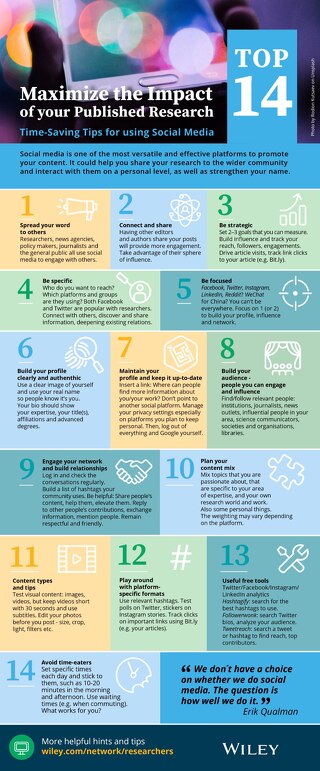4-simple-steps-to-growing-usage-for-your-article-a-guide-to-kudos
June 04, 2015
Your article has finally been accepted and published after rounds of peer review, revision, and back-and-forth conversations with editors. At last, subscribers to the journal can visit and read your new article. Yet as you stare at the share-to-social-media buttons and how-to-cite links hovering near your content, a bit of anxiety begins to creep in: Will they read it?
Publishers like Wiley handle most of the next-steps after an article’s publication, such as its marketing and distribution. They accomplish this through a variety of resources, including sales teams and marketing teams and digital strategy teams. But is there anything that you, as the author, can do?
That’s where Kudos comes in. Kudos is a new, award-winning platform with whom Wiley has partnered to give authors more control over the marketing of their article. According to Kudos’s FAQs, “In a pilot version of Kudos during 2013, researchers using the Kudos sharing tools saw an average increase in downloads of their publications of 19% compared to a control group.”
So, what does Kudos do? As they put it, the platform lets you maximize the usage and impact of your publications in 4 simple steps:
- Explain your work and tell readers what it’s about and why it’s important.
- Enrich your publication by adding links to related materials.
- Share a link to your publication by email and social media.
- Measure the impact of your publication performance.
Every year, the amount of research available, and competing for readers’ attention, continues to grow. Using Kudos, you can give yourself a leg up by building a profile for your article. To get started, sign up for a free Kudos account. If you’re a Wiley author registered on Wiley Author Services, your publication will automatically be linked to your new Kudos account. Those authors not on Wiley Author Services can claim authorship by manually searching for their articles (by DOI, article title, or author name) within Kudos.
After claiming your article, you can begin to develop its profile by including descriptions of your article and its importance. Adding these short summaries and other metadata can help potential readers more easily identify the article contents and gauge its applicability to their research interests.
Do you have a video abstract or other related media? What about a publicly available data set? Kudos lets you combine that information into one location. From there, the service provides you with additional tools and tips to share your profile via a generated hyperlink. This link can then be distributed through social media platforms, email, or blogs and webpages.
To help you measure the amount of interest resulting from these shares, Kudos offers a variety of metrics. These include publication views, full text downloads, social media shares, Altmetrics, and citations. An author dashboard lets you easily track and sort this data, as the platform simultaneously provides suggestions for what else you can do to further enhance your article’s performance.
Not sure what those numbers mean? If you need a bit more context, additional benchmarking tools allow you to compare your article activity to that of your peers’ articles, providing you with the opportunity to adapt and develop your article promotion strategy accordingly.
As of March 2015, over 35,000 users, including 7,000 Wiley authors, have now signed up for Kudos. Don’t let your article get lost in the mix. Join Kudos, and begin showcasing your article today.
A version of this blog post was previously published at the Society for Research on Adolescence blog on June 4, 2015.














